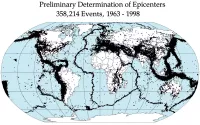Halliburton is a multinational corporation and the world's second-largest oil service company, notable for its significant role in fracking operations. With approximately 55,000 employees, it operates through numerous subsidiaries and affiliates in over 70 countries. The company maintains dual headquarters in Houston and Dubai.
1919: Erle P. Halliburton starts New Method Oil Well Cementing Company
In 1919, Erle P. Halliburton started the company as the New Method Oil Well Cementing Company.
1920: Halliburton brings wild gas well under control
In 1920, Erle P. Halliburton brought a wild gas well under control using cement for W.G. Skelly near Wilson, Oklahoma.
March 1, 1921: Halliburton receives patent for water exclusion method
On March 1, 1921, Halliburton's "method and means of excluding water from oil wells" was assigned a patent from the U.S. Patent Office.
1922: Halliburton Oil Well Cementing Company prospers
By 1922, the Halliburton Oil Well Cementing Company (HOWCO) was prospering from the Mexia, Texas oil boom, having cemented its 500th well in late summer.
1926: First foreign venture begins
In 1926, Halliburton's first foreign venture began with the sale of equipment to Burma and India.
1938: Halliburton cements first offshore well
In 1938, Halliburton cemented its first offshore well using a truck on a barge off the Louisiana coast.
1940: Halliburton opens offices in Venezuela and introduces bulk handling of cementing
In 1940, Halliburton opened offices in Venezuela and introduced bulk handling of cementing to the industry.
1947: Halliburton first marine cementing vessel went into service
In 1947, the Halliburton first marine cementing vessel went into service.
1948: George H. W. Bush works for Dresser Industries
From 1948 to 1951, former president George H. W. Bush worked for Dresser Industries in several positions before founding Zapata Corporation.
1948: Halliburton opened facility in Rock Springs, Wyoming
Halliburton opened an older facility in 1948, which was later replaced by a newer facility in October 2004.
1951: George H. W. Bush leaves Dresser Industries
From 1948 to 1951, former president George H. W. Bush worked for Dresser Industries in several positions before founding Zapata Corporation.
1952: Halliburton revenues top $100 million
In 1952, Halliburton revenues topped $100 million for the first time.
1957: Erle P. Halliburton dies
Erle P. Halliburton died in Los Angeles in 1957. HOWCO is at this time worth $190 million with camps all over the world. The same year, HOWCO purchased Welex, which pioneered jet perforation.
1959: Halliburton acquires Otis Engineering
In 1959, Halliburton acquired Otis Engineering, an oil field service and equipment company specializing in manufacturing pressure control equipment for oil and gas producing wells.
July 5, 1961: Company name changed to Halliburton Company
On July 5, 1961, the company changed its name to the Halliburton Company.
1962: Halliburton acquires Brown & Root
In 1962, Halliburton acquired Brown & Root.
1963: Halliburton receives Presidential "E" for Export flag
In 1963, Halliburton was the first company in Oklahoma to receive the Presidential "E" for Export flag in recognition of notable contributions to foreign trade.
1964: Halliburton opens manufacturing center in Duncan, Oklahoma
In 1964, Halliburton opened a 500,000 sq ft manufacturing center in Duncan, Oklahoma.
1965: Halliburton pilots computer network system
In 1965, Halliburton began a pilot operation of a computer network system, the first such installation in the oilfield services industry.
1966: New wing added to Research Center in Duncan
In 1966, workers broke ground for a new wing at the Research Center in Duncan that tripled the available space for the Chemical Research and Design Department.
1968: Automated mixing system for drilling mud developed
In 1968, Halliburton developed an automated mixing system for drilling mud, primarily for use offshore.
1969: Halliburton begins construction of base camp at Prudhoe Bay
In 1969, Halliburton began construction of a base camp at Prudhoe Bay on Alaska's North Slope.
1974: Gearhart Industries introduces first digital computer logging system
In 1974, Gearhart Industries introduced the first digital computer logging system.
1975: Halliburton Products and Services Ltd. (HPS) incorporated in the Cayman Islands
In 1975, Halliburton Products and Services Ltd. (HPS) incorporated in the Cayman Islands. In 2001 HPS opened an office in Tehran.
1975: Halliburton works with Clean Gulf Associates to clean up oil spills
In 1975, Halliburton responded to environmental concerns by working with the nonprofit Clean Gulf Associates to contain and clean up oil spills.
1976: Halliburton establishes Halliburton Energy Institute
In 1976, Halliburton established the Halliburton Energy Institute in Duncan, Oklahoma, to provide an industry forum for disseminating technical information.
1980: Halliburton Research Center opened in Duncan, Oklahoma
In 1980, Halliburton Research Center opened in Duncan, Oklahoma.
1983: Billionth sack of cement pumped
In 1983, Halliburton's billionth sack of cement for customers was pumped.
1985: Halliburton Headquarters Moved in Dallas
In 1985, Halliburton moved its headquarters within Dallas to Lincoln Plaza.
1988: Dresser merges M.W. Kellogg division
In 1988, Dresser merged within its M.W. Kellogg division.
1989: Halliburton Energy Services acquires Gearhart Industries
In 1989, Halliburton Energy Services acquired Gearhart Industries.
1989: Halliburton acquires Gearhart Industries
In 1989, Halliburton acquired logging and perforating specialist company Gearhart Industries and combined it with its subsidiary Welex to form Halliburton Logging Services.
1989: Thomas H. Cruikshank serves as chairman and CEO
In 1989, Thomas H. Cruikshank serves as chairman and CEO. Cruikshank was replaced in 1995.
February 1991: Halliburton subsidiary Brown & Root Services receives payment to study use of private military forces
Following the end of Operation Desert Storm in February 1991, the Pentagon paid Halliburton subsidiary Brown & Root Services over $8.5 million to study the use of private military forces with American soldiers in combat zones. Halliburton crews also helped bring 725 burning oil wells under control in Kuwait.
1994: KBR bribery of Nigerian officials begins
In 1994, KBR, a subsidiary of Halliburton at the time, started bribing high-ranking Nigerian officials. The bribery continued until 2004.
1995: Cheney Becomes CEO of Halliburton
In 1995, Dick Cheney became the chairman and CEO of Halliburton Company, a position he held until 2000.
1995: Dick Cheney becomes chairman and CEO, replacing Thomas H. Cruikshank
In 1995, Dick Cheney replaced Thomas H. Cruikshank as chairman and CEO. Cruikshank had served since 1989.
1995: Halliburton Misconduct Settlements Begin
Since 1995, Halliburton has agreed to pay settlements of $791 million for 10 instances of misconduct, as detailed in the Federal Contractor Misconduct Database.
1998: Halliburton acquires Dresser Industries and forms Kellogg-Brown & Root division
In 1998, Halliburton acquired Dresser Industries. As a result of the acquisition, the Kellogg-Brown & Root division was formed by merging Halliburton's Brown & Root subsidiary and the M.W. Kellogg division of Dresser.
1998: Halliburton merges with Dresser Industries
In 1998, Halliburton merged with Dresser Industries, which included Kellogg. Prescott Bush was a director of Dresser Industries, which is now part of Halliburton.
2000: Cheney Retires from Halliburton
In 2000, Dick Cheney retired from Halliburton during the U.S. presidential election campaign, receiving a severance package worth $36 million.
2001: Halliburton's Facility Had 230 TRI Air Releases
In 2001, Halliburton's Harris County, Texas, facility reported 230 TRI air releases.
2001: Halliburton subsidiary opens office in Tehran
In 2001, a subsidiary of Halliburton Energy Services, Halliburton Products and Services Ltd. (HPS), opened an office in Tehran, potentially violating the Trading with the Enemy Act. Later, Halliburton announced it would withdraw from Iran.
April 2002: KBR awarded contract to construct steel holding cells at Camp X-Ray
In April 2002, KBR was awarded a $7 million contract to construct steel holding cells at Camp X-Ray.
November 2002: KBR tasked to plan oil well firefighting in Iraq
In November 2002, KBR was tasked to plan oil well firefighting in Iraq.
2002: Halliburton Planned to Move Headquarters to Houston
In 2002, Halliburton planned to move its headquarters to Houston and signed a lease for space in 5 Houston Center.
2002: Halliburton Restates Earnings for Fourth Quarter
In 2002, Halliburton restated earnings downward by $14 million for the fourth quarter.
2002: Halliburton's Facility Had 245 TRI Air Releases
In 2002, Toxics Release Inventory (TRI) reports measured chemical emissions from Halliburton's Harris County, Texas facility, showing 245 TRI air releases.
2002: Kellogg-Brown & Root division is renamed to KBR
In 2002, the Kellogg-Brown & Root division was renamed to KBR.
February 2003: KBR issued contract to conduct oil well firefighting in Iraq
In February 2003, KBR was issued a contract to conduct oil well firefighting in Iraq. Critics contend that it was a no-bid contract, awarded due to Dick Cheney's position as vice president.
March 31, 2003: Halliburton restated earnings downward
On March 31, 2003, management at Halliburton restated earnings downward by $14 million for the fourth quarter of 2002.
May 2003: KBR subsidiary paid Nigerian official $2.4 million in bribes
In May 2003, Halliburton revealed in SEC filings that its KBR subsidiary had paid a Nigerian official $2.4 million in bribes in order to receive favorable tax treatment.
May 2003: AISD offers tax exemption
In May 2003, the Aldine Independent School District (AISD) began offering the same freeport tax exemption as other jurisdictions in order to attract businesses. This decision led Halliburton to retain its North Belt office.
July 2003: Halliburton Moved Headquarters to Houston
By July 2003, Halliburton had moved its headquarters to 5 Houston Center, occupying space on the 24th floor.
August 2004: Plan outlined to divest KBR division
In August 2004, at a meeting for investors and analysts, a plan was outlined to divest the KBR division through a possible sale, spin-off, or initial public offering.
October 2004: Halliburton opens new facility in Rock Springs, Wyoming
In October 2004, Halliburton opened a new 250,000-square-foot facility in Rock Springs, Wyoming, replacing an older facility that opened in 1948.
2004: Cheney Receives Deferred Compensation from Halliburton
As of 2004, Dick Cheney had received $398,548 in deferred compensation from Halliburton while serving as Vice President.
2004: Halliburton books significant losses due to Asbestos-related litigation
From 2002 through 2004, Halliburton booked more than US$4.0 billion in losses due to Asbestos-related litigation from the Kellogg acquisition.
2004: Halliburton settles bribery case for $382 million
In 2004, Halliburton reached a deal with the U.S. Justice Department, agreeing to pay $382 million to settle a bribery case involving KBR paying bribes to Nigerian officials between 1994 and 2004.
2004: Halliburton Restates Earnings for Fourth Quarter
In 2004, Halliburton restated its 2004 fourth-quarter earnings to add $2 million US in after-tax losses.
January 2005: Final Settlement reached in asbestos case
In January 2005, a final non-appealable settlement was reached in the asbestos case which allowed Halliburton subsidiary KBR to exit Chapter 11 bankruptcy and return the company to quarterly profitability.
March 2, 2005: Halliburton Restates Earnings
On March 2, 2005, Halliburton restated its 2004 fourth-quarter earnings to add $2 million US in after-tax losses to reflect the collection of a $10 million receivable that had been reserved and a correction in lease accounting.
September 20, 2005: Halliburton Truck Convoy Ambushed in Iraq
On September 20, 2005, a convoy of four Halliburton trucks was ambushed north of Baghdad; three of the four truck drivers were killed by insurgents.
2005: Jamie Leigh Jones Alleges Gang Rape by Co-workers
In 2005, Jamie Leigh Jones, an employee of KBR (then a subsidiary of Halliburton), testified at a Congressional hearing that she had been gang-raped by co-workers in Iraq.
2005: Analysts believe KBR could be worth closer to $3 billion
In 2005, analysts believed KBR could be worth closer to $3 billion.
2005: Halliburton Loophole Exempts Fracking Chemicals
In 2005, the Energy Policy Act, also known as the Halliburton loophole, exempted chemicals used during hydraulic fracturing from several environmental protection laws.
January 24, 2006: KBR awarded contract to build temporary detention facilities
On January 24, 2006, Halliburton's subsidiary KBR announced it had been awarded a $385 million contingency contract by the Department of Homeland Security to build "temporary detention and processing facilities" or internment camps.
April 15, 2006: Halliburton Files to Sell KBR Stock
On April 15, 2006, Halliburton filed a registration statement with the Securities and Exchange Commission to sell up to 20 percent of its KBR stock on the NYSE.
June 7, 2006: Halliburton's Farmington Facility Creates Toxic Cloud
On June 7, 2006, Halliburton's Farmington, New Mexico facility created a toxic cloud, forcing people to evacuate their homes.
November 2006: Halliburton Begins Selling Stake in KBR
In November 2006, Halliburton began selling its stake in KBR, its major subsidiary.
February 2007: Halliburton Completes Sale of KBR Subsidiary
By February 2007, Halliburton had completely sold off its subsidiary, KBR.
April 5, 2007: Halliburton sells KBR division
On April 5, 2007, Halliburton announced the sale of its KBR division, severing its corporate relationship with the contracting, engineering, and construction unit.
June 2007: KBR Awarded Shared $150 Billion Contract
In June 2007, KBR would share another $150 billion contract with two other contractors, Fluor and Dyncorp, over the next 10 years.
February 2008: Classified information stolen from Petrobras while in Halliburton's custody
In February 2008, a hard disk and two computers containing classified information were stolen from Petrobras while in Halliburton's custody. The content was data on the recently discovered Tupi oil field.
2008: Halliburton outsources IT infrastructure
In 2008, Halliburton agreed to outsource its mission-critical information technology infrastructure to a Dallas/Fort Worth Metroplex data center operated by CyrusOne Networks LLC.
August 2009: Halliburton Implicated in Timor Sea Oil Spill
In August 2009, Halliburton was implicated in the oil spills in the Timor Sea off Australia for improper cementing.
September 15, 2009: Court Rules in Favor of Halliburton in Jamie Leigh Jones Case
On September 15, 2009, the Fifth Circuit Court of Appeals ruled in favor of Halliburton, finding that Jamie Leigh Jones's alleged injuries were not related to her employment.
2009: Halliburton Plans to Move Headquarters to North Belt Campus
In 2009, Halliburton announced plans to move its headquarters to the North Belt Campus in Houston and consolidate operations.
2009: KBR Agrees to Pay Bribes
In 2009, KBR, a former subsidiary of Halliburton, agreed to pay $402 million after admitting that it bribed Nigerian officials.
April 2010: Halliburton Implicated in Gulf of Mexico Oil Spill
In April 2010, Halliburton was implicated in the oil spills in the Gulf of Mexico for improper cementing on the Transocean operated Deepwater Horizon oil rig.
April 2010: Halliburton Destroys Evidence After Deepwater Horizon Disaster
In April 2010, following the Deepwater Horizon disaster, Halliburton destroyed computer simulations that contradicted their claims about BP's adherence to their advice, leading to a guilty plea for destroying evidence.
May 14, 2010: Obama criticizes Halliburton executives
On May 14, 2010, President Barack Obama criticized executives from Halliburton, BP, and Transocean for shifting blame during congressional hearings related to the Deepwater Horizon oil spill.
December 2010: Nigeria files corruption charges against Cheney related to Halliburton
In December 2010, the Nigerian government filed corruption charges against Dick Cheney, in connection with his role as chief executive of Halliburton, regarding an alleged $182 million contract.
2010: Halliburton Involved in Deepwater Horizon Oil Spill
Halliburton was involved in the Deepwater Horizon oil spill, for which they were later found to have destroyed evidence.
2010: BP report blames Halliburton for Deepwater Horizon explosion
In 2010, an internal report by BP claimed that poor practices by Halliburton staff contributed to the Deepwater Horizon disaster, citing an unstable cement mixture.
2010: Scheduled construction of the North Belt administration building
In late 2010, construction of the North Belt administration building was scheduled to begin.
2012: First Phase of Expansion and Renovation at North Belt Campus Completed
In 2012, the first phase of expansion and renovation at Halliburton's North Belt Campus was completed.
July 2013: Halliburton Agrees to Plead Guilty for Destroying Evidence in Deepwater Horizon Case
In July 2013, Halliburton Co agreed to plead guilty to charges that it destroyed evidence relating to the 2010 Deepwater Horizon oil spill, incurring a $200,000 fine and three years of probation.
August 1, 2014: Jeff Miller promoted to President of Halliburton
On August 1, 2014, Jeff Miller was promoted to President of Halliburton, replacing Dave Lesar.
September 2014: Halliburton Agrees to Pay $1.1 Billion in Damages for Deepwater Horizon Explosion
In September 2014, Halliburton agreed to pay $1.1 billion in damages to settle the majority of claims against it relating to the Deepwater Horizon explosion.
November 17, 2014: Halliburton to Acquire Baker Hughes
On November 17, 2014, Halliburton and Baker Hughes jointly announced a definitive agreement for Halliburton to acquire Baker Hughes in a stock and cash transaction valued at $34.6 billion, aiming to compete with Schlumberger.
December 11, 2014: Halliburton details restructuring in integration to follow Baker Hughes acquisition
On December 11, 2014, Halliburton's website detailed the restructuring in the integration to follow Baker Hughes acquisition.
2014: New Buildings Completed at North Belt Campus
In 2014, new buildings, a garage, a cafeteria, and a fitness center were completed at Halliburton's North Belt Campus.
2015: Halliburton Declared Guilty for Retaliating Against Whistleblower
In 2015, Halliburton was declared guilty for illegally retaliating against whistleblower Tony Menendez, who had raised concerns about the company's accounting practices.
April 2016: Deadline for Halliburton to acquire Baker Hughes
In April 2016, the merger between Halliburton and Baker Hughes had a deadline, after which both companies could withdraw if a decision wasn't reached.
May 2016: Halliburton and Baker Hughes terminate merger agreement
In May 2016, Halliburton and Baker Hughes announced the termination of their merger agreement after the deadline expired.
June 1, 2017: Jeff Miller becomes CEO of Halliburton
On June 1, 2017, Jeff Miller was promoted to CEO of Halliburton, replacing Dave Lesar.
2020: Halliburton Refuses Full Disclosure of Gas Drilling Chemicals
In 2020, Halliburton was the only company out of nine that refused to fully disclose the chemicals used in gas drilling when requested by the EPA.
March 1, 2022: Halliburton Inaugurates MultiChem Facility in Jubail PlasChem Park
On March 1, 2022, Halliburton inaugurated its MultiChem facility in Jubail PlasChem Park, transforming Saudi Arabia into an exporter of specialty products.
Mentioned in this timeline

Barack Obama the th U S President - was the...
Nigeria is a West African nation the most populous in...
Schlumberger now known as SLB is a multinational oilfield services...
Venezuela officially the Bolivarian Republic of Venezuela is a country...
Saudi Arabia officially the Kingdom of Saudi Arabia KSA is...
India officially the Republic of India is a South Asian...
Trending
Aaron Jones is an American professional football running back currently playing for the Minnesota Vikings Drafted by the Green Bay...

4 months ago Christian Watson & Jordan Addison Updates: Watson's Comeback and NFC Team Notes

8 months ago Davante Adams expresses optimism about Rams, refused talks with 49ers over offer.
2 months ago Chuba Hubbard Injury Update: Doubtful for Week 5 Due to Injury
6 months ago Nate Burleson Launches LionBlood Vodka with Valentine Distilling; Gayle King's Outfit Choice

14 days ago Earthquake Rattles Northern California on Thanksgiving: Santa Rosa Area Sees 3.3 Magnitude
Popular

Candace Owens is an American conservative political commentator and author...

Ilhan Omar is an American politician currently serving as the...

XXXTentacion born Jahseh Dwayne Ricardo Onfroy was a controversial yet...

Tom Cotton is an American politician and Army veteran currently...

Oprah Winfrey an American talk show host television producer actress...
Matt and Ross Duffer known as the Duffer Brothers are...